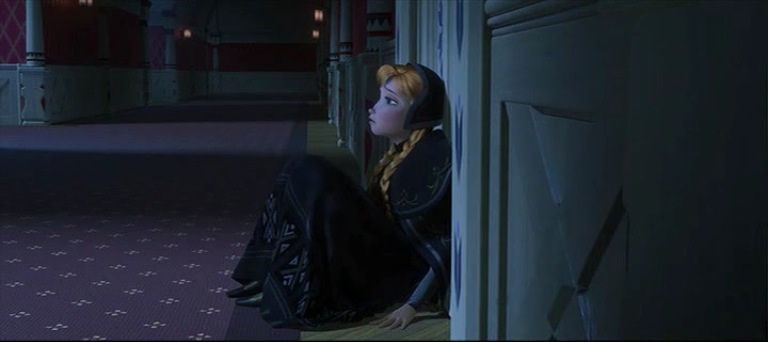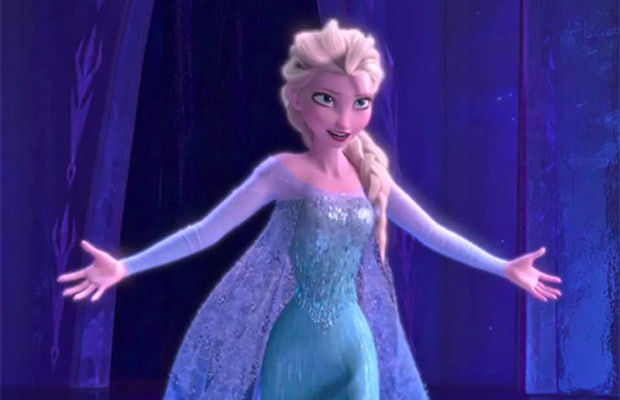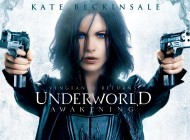Frozen’s Water Part 3: Where it MELTS
In Batman Begins, Rutger Hauer’s character leans over a young Bruce Wayne and tells the boy he’ll keep the company safe until the lad is old enough to run it. It’s a nice touch – a cameo – that establishes pivotal credibility to time between flashbacks in the life of a fictional character. It helps you believe Bruce’s life has depth. Moving swiftly, Pixar’s UP establishes two characters in the opening sequence and we experience a loving couple’s lifetime. In my opinion it’s the best part of that film (and still makes me cry).
A montage is magical when it makes you believe a fictional character’s life moves between those moments… and while not a fatal fracture, this was the first place Frozen cracked. We’re introduced to characters who apparently have NO interaction with each other outside of what we see. I’m not talking about a sequestered sister, I’m talking about parents and a house full of servants who apparently never speak to their Anna or bother offering ANY plausible reason for older sister’s isolation.
Mom and Dad might have suggested Elsa was ill, fragile, lacking an immune system: all sorts of reasonable excuses for why a young girl really would sadly be separated from her sister. Apparently Anna never converses with mom, or inquires of dad? Confides in the maid? If the parents had been portrayed as wicked, evil or uncaring – instead of well-meaning but fallible folks – this might make sense. Here, it felt like shoddy narrative construction.
Moreover, after their parents’ passing… does the country just run itself? Who organizes the servants, runs the house, or conducts trade negotiations with Weselton? Who’s educating and grooming Elsa for her role and responsibilities as Queen? Even a minor character – an overseer in the absence of royal parents (like the Steward of Gondor in LOTR) could have plugged this plot hole with an animation design and a line or two. Years pass while Elsa just sits in her room… and then everybody just expects a shut-in to run the joint? Ooooookay.
While this might not matter to five-year old viewers, it seems sloppy for a Mouse House that often takes great care to write stories pleasing to young viewers while not insulting their parents. There are creative ways to allude to a fuller life in characters, yet all we get in Frozen is enough back-story to inform the exact predicament of the narrative’s focus. Anna and Elsa appear as cardboard cutouts – means to narrative ends – a sad shortcoming for Disney, who usually goes the extra mile.
However, these plot frustrations might be overcome if the story’s theme flowed wonderfully from there. Unfortunately, it doesn’t. While we get a setup about “love at first sight” that leads to one of the film’s solid lessons for Anna (covered in the last post), the significant point of conflict portrayed is Elsa’s breakdown, an altercation that causes her departure, and inspires an anthem… a lyrical liberation now on the lips of people round the world. The actual point of the film’s narrative seems to have been co-opted by culture – or marketing – and stalled midway at this point in the film.
And what exactly, we might ask, is this verbal flag of freedom? Here’s a few samples sandwiched between the feel-good lyrics:
Be the ‘good girl’ you always have to be
Conceal, don’t feel, don’t let them know…
Well now they know!
Let it go…
LET IT GO!
It’s time to see what I can do,
To test the limits and break through…
No right, no wrong, no rules for me, I’m free!
I’m never going back… The past is in the past.
That ‘perfect girl’ is gone…
I remember when some people freaked out about the “Circle of Life” philosophy in The Lion King… but put that aside for a moment, because I don’t think you’re gonna find a more jacked up song than “Let it Go.” Stay with me, here… for just a moment I want every earnest parent to consider what they’re lauding alongside their soon-to-be-Elsa’s-age daughters (and boys: let’s be equitable here). I’m sure we’re all anxiously awaiting the day our kids say “F— all y’all, I’m out of here… and I don’t need your ethics, values, morals, or any of that crap. I’m free.”
No right, no wrong, no rules for me… I’m free?
Now since your kids don’t have ice powers exploding during their pubescent years, in what direction might this metaphor manifest as they blossom into adulthood? When they stop trying to be good girls and boys with disdain and disgust for the notion, what exactly are they going to seek out? Hmmm.
A look at Elsa’s path is very telling: although she doesn’t seek to do anything except liberate herself and be unconstrained, those actions leave a massive trail of chilling, ignorant destruction in their wake.
“‘The wake’ is the results we leave behind. And the wake doesn’t lie and it doesn’t care about excuses. It is what it is. No matter what we try to do to explain why, or to justify what the wake is, it still remains.” – Dr. Henry Cloud, Integrity
As the frustrated girl in Frozen sings her song of self-liberation, casts off all restraint, and then sets her new course – creating things like the snow creature – she puts pieces into play that will nearly cause the death of others. And her sister! Even sending Anna away from her presence “for her own good” sends her into the open maw of the monster. How’s that “freedom” working out for you? Yeah… all Elsa does is make things much, much worse, yet people the world over are embracing this mid-movie melody as if it were a new life proverb.
While Elsa clearly needs MORE than self-control and self-discipline, the binary message of the film leaves young, unguided viewers with disdain for them. In the real world, there are moments, situations and scenarios where we must conceal and keep feelings in check, where we must exercise restraint… unless we’re “lucky” enough to land a job on a reality television show like Jersey Shore.
And the role of Elsa will be played by… Snooki! Or maybe Miley?
While younger sister Anna has to learn a lesson about double checking her feelings in the course of the film, and becomes an instrument of salvation for others, the depth of solution revealed for Elsa’s struggle is ultimately summed up with something akin to “all you need is love.” Her transformation comes with all the depth of a cheesy Beatles song. I’m bummed that her character gets short shrift. Some well-placed lines of dialogue near the end could have fleshed this out better.
What’s more bizarre is how people seem to lift up the message of this song as laudable when it isn’t even consistent with the narrative. The protagonist is Anna, not Elsa, seeking to turn a sister’s course which might have led her to become a villain. Elsa’s song boldly declares how she’s never going back (yet she does). Spoiler alert: she reconciles and resumes her role (which certainly means some rules are back too). And, of course, the narrative’s REAL ne’er-do-wells are punished for their schemes (hey, what happened to no right, no wrong, no rules for me? Did that only apply to Elsa?). Right and wrong are still being administrated… happily ever after. In other words:
The power ballad we’re all singing gets nowhere near providing a solution: it’s a song about license, not liberty.
Now I want to be sympathetic here: one can imagine some adults truly had wicked parents – children who were physically abused, sexually abused – and might latch onto parts of “Let it Go” because they DID need to leave, drawing a line in the sand and forging a new legacy. However, that’s not what’s portrayed in Frozen: the story shows Elsa and Anna’s parents as flawed, ignorant perhaps, but not the wicked stepmothers of fairy tales… or worse, real life.
Clearly, the anthem that emerges in the middle of the film is the ranting of a confused young adult reveling in a sense of newfound freedom, which turns out to be more destructive than the strictures she faced before. Yet, although the narrative restores and reconciles by the end… the horribly flawed lyrics reappear as credits roll and we’re encouraged to sing along! If that logic could be visually depicted as our friendly snowman Olaf, it’s clear someone put the butt where the head should be. The big, probably-Oscar winning musical number everyone croons clearly cracks under the events of the third act… yet I wonder if anyone is paying attention. More likely, they’re just “feeling” a sense of lyrical liberation with the same kind of passion Anna felt when she was “certain” Hans was her one and only love.
And we know where THAT would have gotten her.
The ending does feature Anna’s “act of true love“… so the false freedom song is sandwiched between healthier lessons. My concern is that most walk away chewing naively and gleefully on the spoiled meat at story’s center. The liquid logic of “Let It Go” is like Hans’ horse lifting a hoof and letting the boat go: it makes its adherents embarrassingly drenched – or worse, drowning – in flimsy, false ideas of self-determined identity instead of real freedom.
“Do you not know… you are servants of the one whom you obey: either of sin, which leads to death, or of obedience, which leads to righteousness? But thanks be to God, that you who were once servants of sin have become obedient from the heart to the standard of teaching to which you were committed, and… have become servants of righteousness. For just as you once presented your members as slaves to impurity and to lawlessness leading to more lawlessness, so now present your members as servants to righteousness… you have been set free from sin and have become servants of God, the fruit you get leads to sanctification and its end, eternal life.” – Romans 6
Belting out “Let it Go” makes about as much sense as Olaf’s Ode summer song: we’re glorying in something that actually reduces and destroys us. In Olaf’s case that’s what makes his song hilarious and ironic – but with Elsa’s song people aren’t getting the nuance. Her anthem, unchecked, is about lawlessness that leads to more lawlessness, even death. Stop trying to be good? Stop desiring perfection? On the contrary: Christian love – the kind of sacrificial love Anna clearly demonstrates to her sister in the film– doesn’t leave us with advice to “let it go”. We aren’t called to self-determined freedom, we’re called to sacrificial service… to live and be true love toward God and others. We aren’t called to “follow our heart”, we’re called to be obedient to the heart of righteousness. And one primary fruit of that is self-control.
It’s the beautiful, creative paradox of the God’s true story: we are set free to become servants.
We don’t have to give up being good, or longing for perfection: the sacrificial love in God’s story provides for us, equips us to keep going… to endure, to be perfected in our Lord’s love (and to even know what that love is supposed to look like). In Him we don’t face eternal winter – in Him we have eternal love.
When a film for adults meanders with a moral muddle, it can be helpful to stimulate conversation. However, when it’s a story for children – when mixed messages are fired ignorantly like icy blasts at the heads and hearts of young, impressionable minds – I wonder which parents will actually sit down and have a conversation with their kids on how to duck, weave and discern them.











